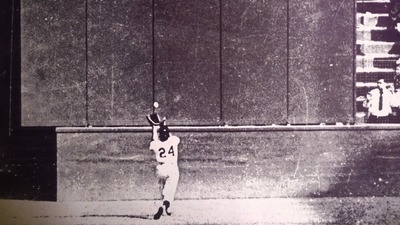Throughout his baseball career and after, Mays was often seen on television screens in other ways. He appeared as himself in episodes of “This is Your Life,” “The Donna Reed Show,” “Bewitched,” “The Joe Namath Show,” “The Merv Griffith Show” and more. He also voiced himself in the animated short “Willie Mays and the Say-Hey Kid.” It’s telling how much television Mays did. He was not only a ball player for the television, he was a Black ball player for the television age. That was rare.
Negro League games weren’t broadcast on the radio until 1942 (twenty-one years after the majors). The first Negro League World Series game wasn’t televised until 1948. For reference: the first MLB World Series was televised in 1947 (a series Jackie Robinson played in). Because Negro League games weren’t always covered in newspapers—when they were, they were usually covered by the Black press in newspapers like The Chicago Defender and The Pittsburgh Courier—and box scores were not regularly kept, most of the exploits of those Black players only lived in the minds of the people who watched them play, becoming apocryphal stories to be passed down. No one truly knows how fast Cool Papa Bell was or how much power Josh Gibson really had. And while we do have some stats (MLB recently decided to integrate Negro League statistics with theirs, adding ten more hits to Mays’ hit log), they remain a small window to the daily wonderment Black baseball provided.
But Willie Mays was different. While Robinson broke the color barrier when he was 28-years old, thereby, limiting how much of his peak was seen by everyone—nearly all of Mays’ peak was televised. If you were a Black man like my father, for the first time, the stories of superhuman exploits no longer sounded made up. You could point to actual proof that this did happen. You could point to the Trenier’s Say Hey song. You could point to “the catch.” You could point to Mays’ moonshots.
Recent documentaries have only deepened the legacy television set. And while I love to see Mays permanently enshrined as folk hero, I’m also worried that we may come to flatten the man behind the highlight reel. I personally wish a documentary like “Say Hey, Willie Mays!” hadn’t totally perpetuated his smoothed image. Mays was a joyous player, yes. But he was also a fierce competitor.
In a post-credits scene from the documentary, for instance, he recalls breaking a catcher’s leg during a game. “Del Rice, good guy,” says Mays. “Then why did you break his leg,” asks Nelson George, the film’s director. “Because he got in the goddamn way,” Mays spits back. That was Willie Mays. That was the player my dad, and many Black men of his generation revered and loved, and tried emulate. That was the Mays who inspired many to adopt the basket catch and made many fall in love with the poetry of the game. That was the speed, the power, the flash, confidence, and tenacity. That was the player, I wish, to this very day, I could have seen play. I envy the many who did, and who will not soon forget, the greatest to player to ever play the game, the “Say Hey Kid.”

